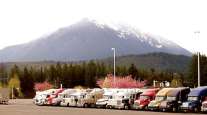Staff Reporter
ELD Mandate Magnifies Parking Shortage, Washington Truck Exec Says

Truckers in Washington state are meeting with lawmakers to discuss options for addressing the state’s shortage of truck parking, an issue which is expected to face added pressure once the federal requirement for use of electronic logs takes effect next week.
The law, which takes effect Dec. 18, mandates that commercial drivers who are required to record their hours of service do so with electronic devices, rather than paper log books. In preparation for the rule, Washington Trucking Associations is meeting with lawmakers to discuss the state’s shortage of parking for trucks, and legislators are starting to gain interest, grasping that the issue affects not just metropolitan areas but the entire state, said Executive Vice President Sheri Call.
YOUR GUIDE TO THE MANDATE: Downloadable PDF.
“What’s kind of driving some of the issue is the implementation of the ELD mandate. A lot of people are attributing it to the ELD mandate and the lack of facilities available for trucks to safely park,” Call said. “You have to stop. You can’t go down the road and fudge the log.”
A 2016 truck parking study from the Washington State Department of Transportation revealed that the state faces a severe shortage of truck parking spaces. According to WSDOT Rail, Freight and Ports Division spokeswoman Janet Matkin, there are 3,160 truck parking spaces available in the state. About 2,442 spaces are private, and 718 are public.
Jason Beloso, strategic planning manager of WSDOT’s Rail, Freight and Ports Division, said that Washington ranks No. 44 out of 50 in terms of parking spaces per 100,000 daily truck vehicle miles traveled and No. 38 for number of spaces per 100 miles on the national highway system.
Despite the lack of parking, freight movement is important for the state. According to WSDOT, daily truck traffic on the state’s major routes increased from 2015 to 2016; the portion of Interstate 5 that runs through Tacoma saw 21,086 trucks a day in 2016, a 34% increase from the prior year. Beloso identified interstates 5, 90 and 405, all of which intersect Seattle, as critical areas in which truck parking is needed.
“In the previous study, the areas where truck parking was needed was limited to certain portions of those corridors,” Beloso said. “In this study, we determined that truck parking really is needed throughout the entire length of those three interstates.”
To address this problem, WSDOT created a map that shows where truck parking spaces are dispersed throughout the state, accounting for rest areas, weigh stations and private truck stops. In addition to indicating how many spaces are available at a certain facility, the map details what amenities are available at each site, such as showers, food service, vending machines, fuel and electrified parking spaces.
2017 Statewide Truck Parking Map by Transport Topics on Scribd
The map exists both as a PDF document on WSDOT’s website and as a paper copy distributed at maintenance areas, commercial vehicle service offices, rest areas, state patrol offices and commercial driver schools. At safety rest areas, the maps are also available in poster format, according to Beloso.
“I kind of look at it as a low-cost, low-tech solution,” Beloso said. “It’s not intended to be a silver bullet. It is a tool that truck drivers could use.”
Beloso said WSDOT is working with the agency’s GIS team to bring the map onto an online, interactive platform that will offer frequently updated information. WSDOT provided the trucking association, based in Olympia, with 200 copies of the map. Although Call said the department’s efforts are useful, she said the brochure map only is limited in terms of “real-time” information.
“We distribute it and offer it to everybody that we possibly can but it, indeed, is not an interactive map,” Call said. “It kind of helps them focus on the fact that there is parking, but there’s nothing interactive or predictable.”
In addition to offering maps and planning for technological platforms that broadcast the availability of truck parking, Beloso said WSDOT is also examining ways to create more spaces.
For example, he said many rest areas along corridors have lawn or grass space that could be transformed into a few additional parking spaces. He said it is a matter of working with partners in the industry to turn such green spaces into parking spots.
“We continue to look at maximizing the system and looking for greater efficiencies,” Beloso said.
The issue of truck parking extends beyond Washington. The shortage of available truck parking ranked No. 4 on American Transportation Research Institute’s list of most pressing concerns for the industry, which was released Oct. 23. The upcoming federal ELD mandate ranked No. 2 on ATRI’s list.




